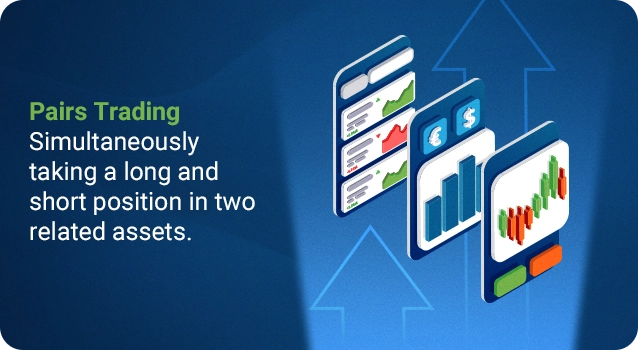Pairs Trading

Welcome to our guide to Pairs Trading – one of the best market-neutral trading strategies. Initially developed in the mid-1980s by Morgan Stanley quantitative analyst Nunzio Tartaglia, it once was a secretive trading strategy that gave institutional traders and hedge funds a competitive edge. Thanks to the advent of high-speed computing and online trading platforms, which made sophisticated, real-time data analysis accessible to individual traders, this once-niche tactic has been brought to the mainstream and has since become a cornerstone in modern Trading Strategies. While attractive due to the potential for profiting in any market condition and its risk-minimizing nature, this cornerstone of modern trading requires an in-depth understanding. So, buckle up and prepare to dive deep into this fascinating world of Pairs Trading!
So, buckle up and prepare to dive deep into this fascinating world of Pairs Trading!
What is Pairs Trading ?
To make the plunge into the depths of Pairs Trading, we must first understand just what Pairs Trading is. So, what is it exactly?
Pretty much the trading world's way of saying "birds of a feather flock together"! Pair Trading differs from other trading strategies that are laser-focused on how one single security performs. Instead, with this tactic, you're focusing on the price difference between two connected assets and work under the idea that two closely related securities will move together over time when they share a commonality.

How does Pairs Trading work? Pair traders will pinpoint a pair of related securities. Then, based on how the prices of these two linked financial assets have historically interacted, the trader will step in. When one asset scores higher than its partner, a Pairs Trader will typically buy into the weaker one and sell the stronger one, holding out for their prices to sync up. As the prices eventually reconverge and the value of the underperforming asset increases, a Pairs Trader will sell the asset with a rising value and profit.
Key Takeaways
Pairs Trading focuses on the price difference between two related assets and the idea that closely related securities move together over time.
Pairs Trading involves buying a weaker asset and selling a stronger one, waiting for their prices to align.
As prices converge, the underperforming asset's value increases, and it is then sold for profit.
Pair Trading Advantages
By predicting the convergence of divergent securities and profiting from it, Pairs Traders can function independently of overall market trends, making Pairs Trading a market neutral strategy. This is precisely where the appeal of this strategy lies, as market conditions or direction, be it bear or bull, are not a constraint. In fact the opposite is true: Pairs Trading thrives on volatility in the individual securities' price disparities!
Unlike traditional investing strategies that rely heavily on market stability for growth, Pairs Trading simply focuses on the improvement of one security and the hope that this will translate into an equivalent depreciation in the other. This negates the overall impact of market movements.
As the long position trading Strategy and short position trading Strategy offset any potential loss brought on by overall market trends, Pairs Trading assumes very little market risk.
Pair Trading Disadvantages
While the market neutrality of Pairs Trading is a huge advantage, it's critical to understand that the strategy itself is not entirely foolproof - primarily as pairs fall in and out of favor and past correlation might not persist. Although the idea of Pairs Trading is predicated on high asset correlation, this relationship isn't always consistent in the long run.
A classic example is the well-known pairing of Coke and Pepsi. Despite being a textbook duo often referred to in trading courses, a Pairs trading strategy with these two has suffered losses for several years. It's essential to remember that past performance doesn't assure future returns. Regardless of correlations established over time, predicting future asset prices is uncertain. Although historical prices can provide insights, they don't guarantee future results.
As a result, traders are always on the look-out for new pairs, while dropping those which are not profitable anymore. However, figuring out when to stop trading a pair or deciding if it's reliable enough to be added to your trading rotation isn't as simple as looking over stocks - it requires a statistical, Technical Analysis of the two securities’ correlation.
How do I calculate correlation?
Establishing a trading pair’s correlation is crucial in successful Pairs Trading. This is typically determined using statistical methods, most commonly the Pearson correlation coefficient - a measure of the linear correlation between two variables. You crunch the historical price data of the two securities, feed this data into the correlation equation, and the magic happens! The output ranges from -1 to +1. A positive correlation near +1 indicates the pair usually moves in the same direction, while a negative correlation near -1 means they typically move in opposite directions.
Pairs Trading example
Imagine you're keeping an eye on two technology giants, Microsoft (MSFT) and Apple (AAPL). Historically, these two companies have maintained a consistent ratio in their prices and tend to move together because they operate in the same industry - a classic indication for a Pairs Trade. However, recently, you notice that although Apple has been on a roll for a while with its price surging consistently over a period of time, Microsoft, though not doing poorly, hasn't seen the same sharp rise and has stayed relatively flat.
This phenomenon creates the perfect opportunity for a Pairs Trade. Observing their correlation, you correctly surmise that Apple has become overpriced relative to Microsoft, or "dislocated" as known in trading terms. So, you decide to go short on Apple (betting its price will fall) and long on Microsoft (expecting its price to rise) - assuming the price ratio will revert to its average price (mean) and aiming to capitalize on this anticipated convergence of the stock prices.

As weeks go by, just as you predicted, Apple slows its bullish run, and Microsoft starts catching up. Well done: you've just successfully executed a 'Pairs Trading' strategy!
This is a classic example of taking advantage of market 'inefficiency' by relying solely on the statistical correlation between the Pair in any market.
Trading Pairs on Crypto
Pairs Trading in the Crypto market does not differ much from other markets, as it still involves buying and selling two correlated cryptocurrencies: e.g., Bitcoin (BTC) and Ethereum (ETH). However, the correlation between cryptocurrencies behaves differently than it does for stock or forex pairs.

While the correlation in stock pairs is typically driven by fundamental factors like company performance and economic trends, in cryptocurrency, the correlation between two crypto coins can vary significantly because it's often driven by investor speculation and crypto market sentiment, which can shift abruptly and unexpectedly.
For instance, a sudden news item or social media trend may swiftly alter the perceived value of a cryptocurrency and break previously reliable crypto correlations, such as the one between Bitcoin and Ethereum. Imagine you've gone long on Bitcoin and short on Ethereum based on their historical correlation. However, a sudden tweet from a prominent tech figure like Elon Musk or news about a significant technological advancement in Ethereum's network hits the internet. This could fuel a flurry of purchases of the Ethereum cryptocurrency, inflating its value almost instantly – while you were betting on an ETH price decrease. Simultaneously, the American government may announce stricter regulations for cryptocurrencies, leading Bitcoin to stray from the expected appreciation and a significant divergence within your pair - ultimately, threatening your perfectly planned Pairs Trade. This increased volatility makes Pairs Trading in crypto much more volatile than traditional fiat currencies.
How to trade Crypto pairs
Though the crypto market’s volatility presents challenges, a well-prepared trader can still use Pairs Trading in the crypto market to their advantage. The key lies in understanding the dynamics that drive these sharp price movements by regularly monitoring crypto market news, being aware of shifts in investor sentiment, and staying updated with developments in the crypto industry so you can predict short-term crypto divergence and convergence patterns as best as you can.
Stock Pair Trading
Pairs Trading in the stock market is uniquely distinguished from Pairs Trading in other markets primarily due to the distinct nature of stocks. The most significant difference lies within the correlation factor. In the stock market, Pairs Trading relies heavily on the strong correlation between two stocks - often within the same sector. Pair traders capitalize on temporary price disparities between these two closely related stocks, expecting any deviation from their average correlation to be short-lived and their prices to reconverge. This emphasis on correlation differentiates stock Pairs Trading from similar strategies in the forex or commodities market, where supply and demand dynamics or macroeconomic factors may hold more sway.

Furthermore, the stock market’s broad availability of company information facilitates a comprehensive analysis for pairs selection, creating a more informed risk mitigation strategy. Now, while it remains an advanced trading strategy requiring sophisticated market comprehension and careful selection, the flexible nature of Pairs Trading, alongside the advent of automated trading systems, has rendered it more accessible for diverse trader profiles seeking portfolio diversification and risk-adjusted returns.
Pair Trading Stock List
If you’re interested in diving into Pairs Trading with a stock pair, the Pair Trading Stock List can be a handy tool for any trader looking to dive into Pairs Trading. Essentially, it's a curated list of stocks that move together—typically due to being in the same industry or having similar market influences. As this is the exact same correlation a Pairs Trader is looking for to execute a successful Pairs Trade, this is where a Pair Trading Stock List comes in.
Have a look at the table below containing classic examples of stock pairs:
Pair Trading Stock List Example
Coca-Cola (KO)
PepsiCo (PEP)
Royal Dutch Shell (RDS.A)
BP (BP)
Walmart (WMT)
Costco (COST)
McDonald's (MCD)
Yum! Brands (YUM)
Amazon (AMZN)
Alibaba (BABA)
Visa (V)
Mastercard (MA)
Exxon Mobil (XOM)
Chevron (CVX)
Johnson & Johnson (JNJ)
Procter & Gamble (PG)
Ford (F)
General Motors (GM)
Such lists, often provided by trading platforms or financial websites, do the hard work for you by identifying potentially correlated stocks – so you don’t have to.
Pair Currency Pairs
Due to their high liquidity and vast availability of data, Currency Pairs are one of the most popular choices for Pairs Traders as they form the backbone of the vast forex market. A currency pair basically consists of two different types of currencies, where one currency is being bought and the other sold. These pairs are represented as a ratio that showcases the value of one currency relative to the other.
An example of a major currency pair is the EUR/USD, where the Euro is the base currency (the first currency listed), and the U.S. Dollar is the quote currency (the second listed currency). The base currency’s value is always 1 when compared to the second currency, while the quote currency’s value tells you how much it costs in relation to the base currency. This means that the EUR/USD Currency Pair ratio represents the amount of USD needed to buy one Euro.
Best trading currency pairs
When it comes to trading currency pairs, a few stand out as popular choices among traders. As already mentioned, the EUR/USD pair is often a favourite due to its high liquidity and low spread – but more importantly, its trends are somewhat predictable. This is thanks to its status as the most traded currency pair globally and its influence by key economic data.
Another top pick is the GBP/USD pair, often referred to as 'cable' – a nickname for the Pair dating back to the 19th century when GBP and USD transactions were executed through the undersea transatlantic telegraph cable. While the Cable tends to have a higher spread than EUR/USD, it can offer high volatility, creating potential opportunities for profit.

Lastly, pairs like USD/JPY and AUD/USD also remain favourites due to their strong market trends and clear technical patterns.
CFD Pairs Trading
Pairs Trading in the Contract for Difference (CFD) market is notable for certain unique characteristics, distinct from Pairs Trading in stock and crypto markets. Traders do not own the underlying asset in CFD trading; instead, they speculate on price differences, which allows them to benefit from both upward and downward market movements. This capability to short an asset, vital to the Pairs Trading strategy, sets the CFD market apart.

Another key feature of CFD Pairs Trading is the leverage offered, which can potentially magnify profits, though it can escalate losses as well. Unlike stocks and cryptocurrencies, CFD markets allow trading across different asset classes - from indices and commodities to foreign exchange and bonds. This provides diverse opportunities for traders to identify and trade two highly correlated instruments.
However, the very nature of trading on borrowed capital makes CFD Pairs Trading riskier compared to traditional stock markets and somewhat volatile crypto markets as you're not actually buying the assets, rather, just speculating on the price difference between opening and closing a trade.
You can potentially make a much larger profit than your initial investment depending on the market's fluctuation.
Conclusion
In conclusion, Pairs Trading is considered one of the best market-neutral strategy by many traders. Initially exclusive to institutional traders, is now accessible to individual traders due to advancements in technology. Pairs Trading possesses advantages like functioning independent of overall market trends and assuming limited market risk. However, it’s also subject to setbacks. Correlations between assets aren’t always consistent, and historical prices don’t assure future returns. While the strategy is implementable across markets, including the volatile crypto market, it requires comprehensive understanding and requires regular monitoring of market news and industry developments.
Welcome to our guide to Pairs Trading – one of the best market-neutral trading strategies. Initially developed in the mid-1980s by Morgan Stanley quantitative analyst Nunzio Tartaglia, it once was a secretive trading strategy that gave institutional traders and hedge funds a competitive edge. Thanks to the advent of high-speed computing and online trading platforms, which made sophisticated, real-time data analysis accessible to individual traders, this once-niche tactic has been brought to the mainstream and has since become a cornerstone in modern Trading Strategies. While attractive due to the potential for profiting in any market condition and its risk-minimizing nature, this cornerstone of modern trading requires an in-depth understanding. So, buckle up and prepare to dive deep into this fascinating world of Pairs Trading!
So, buckle up and prepare to dive deep into this fascinating world of Pairs Trading!
Table of Contents
FAQ
Pairs Trading can be suitable for beginners, but it depends on the individual's understanding of the market, patience, and ability to analyze and understand complex financial data. It's always recommended to thoroughly research and possibly consult a financial advisor before starting any new trading strategy.
Yes, Pairs Trading is often considered a form of arbitrage. Specifically, it is known as statistical arbitrage. Traders aim to profit from the price difference between two correlated securities when the relationship between their prices diverges and then converges again.
Yes, there are several types of Pairs Trading strategies. These may include Statistical Arbitrage, which involves making trading decisions based on statistical analyses; and Relative Value, where trades are made based on the relative value of similar securities. The best approach can depend on a variety of factors including your trading experience, risk tolerance, and market conditions.












